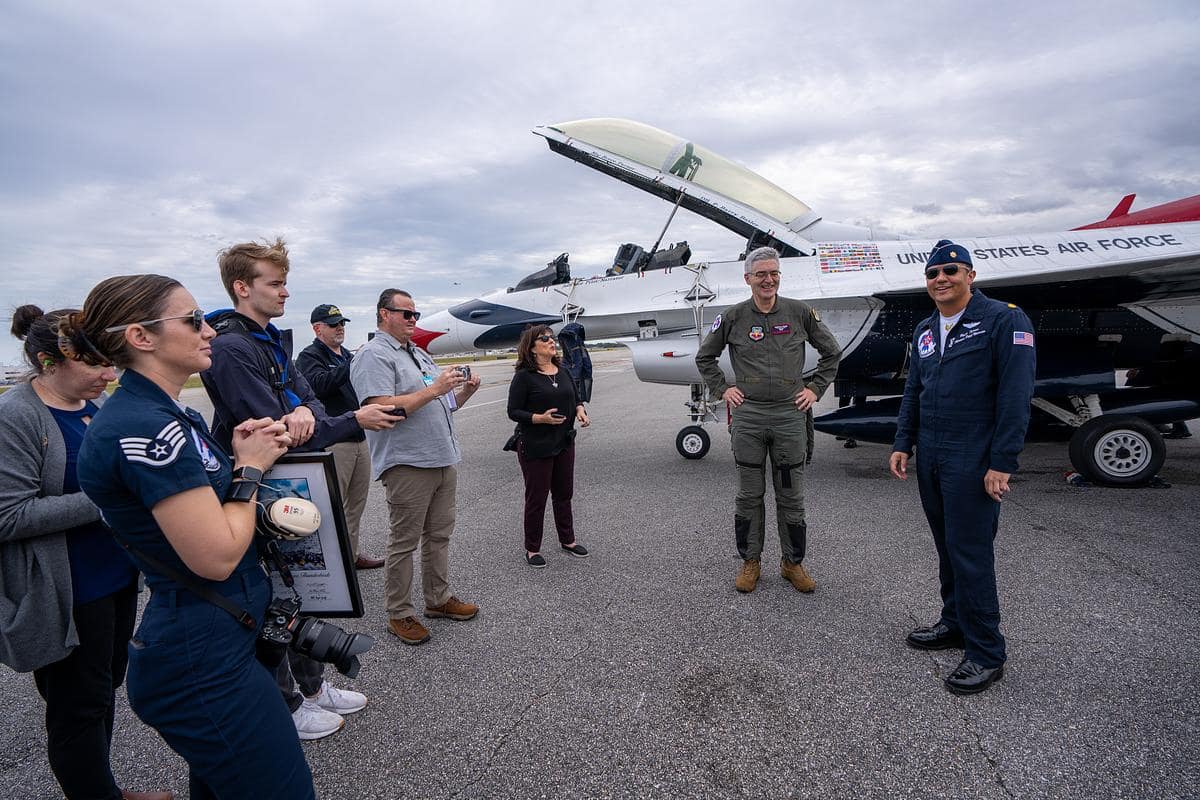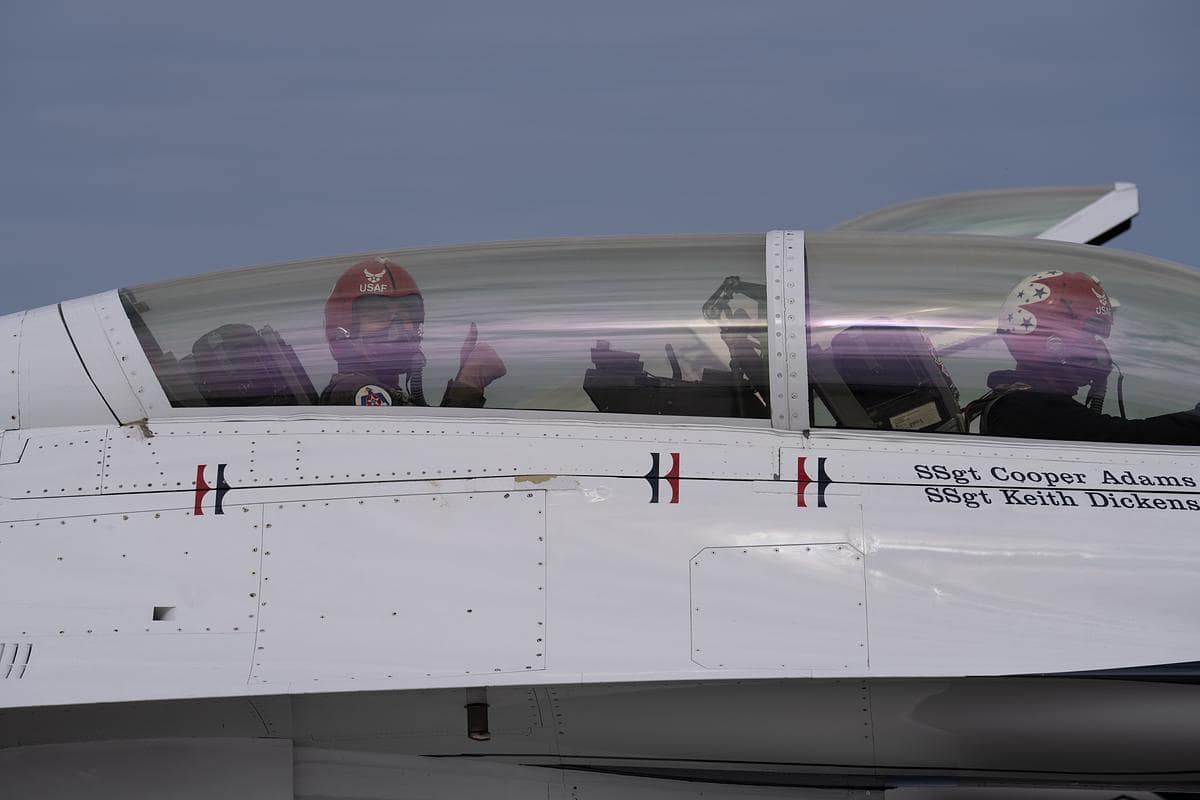The Thunderbirds Meet with Cadets, Buzz Campus and Take Embry-Riddle's President on a 'Hometown Hero' Flight

The U.S. Air Force Thunderbirds flight team — in town for the Daytona 500 — visited two Air Force ROTC classes at Embry-Riddle Aeronautical University, zoomed over the Daytona Beach Campus on Feb. 15, and gave President P. Barry Butler, Ph.D., the ride of his life.
The Thunderbirds’ mission is to support the U.S. Air Force’s recruiting and retention efforts by showcasing the excitement of flight with their soaring aerobatic displays in iconic red, white and blue F-16 Fighting Falcon jets.
That mission is “well aligned with Embry-Riddle’s long history of serving those who serve, and our goal to inspire young people to pursue aviation careers,” Butler said, adding that he was deeply honored to fly with Thunderbird 8, Maj. Bryce “Triple” Turner.
During a safety briefing, Thunderbird 8 said he would fly close to supersonic speeds but without breaking the sound barrier, and he shared a technique called, “Squeeze (your core muscles), breathe, and get ready for the Gs.” Butler suited up and climbed into a jet, smiling.
After a surprisingly short roll on the runway, the F-16 thundered into the clouds at a nearly vertical angle and then reappeared as it looped southward. The hour-long flight to Cape Canaveral and back to Embry-Riddle featured soaring, twisting maneuvers and reached a top speed of about 500 knots (575 mph).
A video version of Butler’s experience, recorded by David Massey, is online here and features Air Force GoPro footage.
As a crowd of students watched atop Embry-Riddle’s Aviation Maintenance Building, Thunderbird 8 ripped through the sky above their heads, circled campus and landed back at Sheltair, adjacent to the Daytona Beach International Airport.
Back on the ground, Butler and Thunderbird 8 were greeted by a half-dozen AFROTC cadets, accompanied by their commander, Col. William Dayton; Student Government Association President Evgeniia “Jane” Egorova and Vice President Ander Turueno Garcia; The Avion’s Editor-in-Chief Andrew Harker; Embry-Riddle ambassador Dr. Audrey Butler; and local news media. Planeside, students mingled with various members of The Thunderbirds team.

Strapped into his seat inside of a F-16 Fighting Falcon jet, Embry-Riddle President P. Barry Butler, Ph.D., prepares for his flight with the USAF Thunderbirds. (Photo: Embry-Riddle/David Massey)
Butler described his journey with Thunderbird 8 as illuminating. “Flying with The Thunderbirds renewed my great respect for the skill and bravery of our military service members,” he said. “I also gained new insight to the student experience at Embry-Riddle. It was humbling to think about the courage of every aviation student who perseveres with their education to become a successful, safety-focused aviator.”
Also during their visit to Daytona Beach, seven members of The Thunderbirds team — including two pilots, a flight surgeon, several public affairs professionals and an F-16 maintenance expert — made a surprise visit to two AFROTC classes. Each team member described their career path and discussed the process of becoming a Thunderbirds pilot. As examples, their insights included these comments:
- Thunderbird 7, Lt. Col. Taylor Wright, noted that “11 to 12 years of experience is the sweet spot” for pilots who want to join The Thunderbirds.
- He added that the hiring process is lengthy and deliberative. New team members must be both exceptionally skilled and a good fit for the group because “we spend more time with each other than we do with our families,” he explained.
- Thunderbird 9, Maj. (Dr.) Jacob Hall, a flight surgeon, advised a student who was interested in aviation medicine to get her “RN, BSN” credentials, then gain familiarity with aircraft.
- Staff Sgt. Breanna Klemm explained how she leverages a variety of multimedia formats, including aerial photography, to promote The Thunderbirds across social media.
The Thunderbirds have a special connection to Embry-Riddle. The team’s leader and commander, Col. Nathan Malafa, graduated from the Worldwide Campus with a master’s degree in Aeronautical Science in 2012. In addition, Dr. Ken Witcher, dean of the Worldwide Campus College of Aviation, was a member of The Thunderbirds during his 20 years of service in the Air Force.
However, Dr. Butler’s ride-along flight was a first, said Chief Flight Instructor Ivan Grau, who helped coordinate the opportunity. “No one from Embry-Riddle had ever been invited to take this type of flight before,” said Grau, a 1988 alumnus. “Dr. Butler is perfect for it. He loves aviation. He’s an avid pilot. Who more deserving to fly with The Thunderbirds than the president of the world’s largest aviation university?”
Suzette Niessner (’16), senior assistant chief flight instructor at Embry-Riddle, described flying with The Thunderbirds as a dream-worthy opportunity. “Anybody who flies an airplane wants to go fast,” she noted. “They want to fly the biggest, strongest, fastest jet.”
With a wingspan of 32 feet, 8 inches, the F-16 Fighting Falcon is capable of traveling up to 1,500 miles per hour (Mach 2 at altitude). The Air Force describes the jet as “a compact, multi-role fighter aircraft” that is “highly maneuverable and has proven itself in air-to-air combat and air-to-surface attack.”
Butler — a fan of The Thunderbirds since grade school — called them “amazing individuals.”
The Thunderbirds’ social media posts about Butler’s flight emphasized Embry-Riddle’s commitment to broadening the aviation pipeline, through the Gaetz Aerospace Institute, a dual-enrollment pathway for high school students, and the Boeing Scholars program, which provides support for women and underrepresented groups as well as veterans.

 Ginger Pinholster
Ginger Pinholster